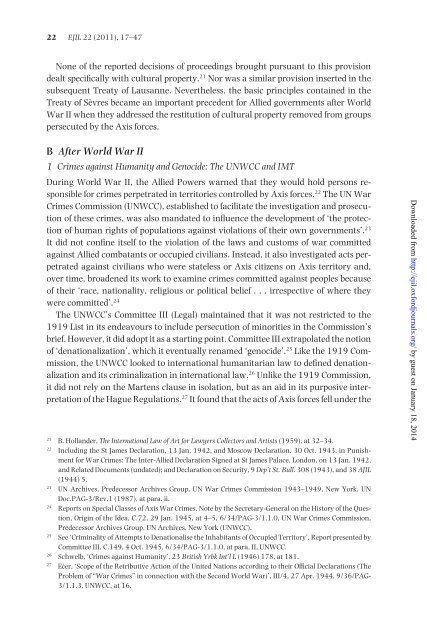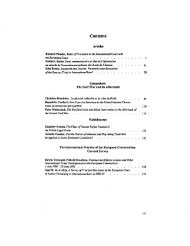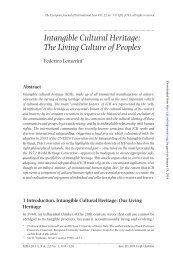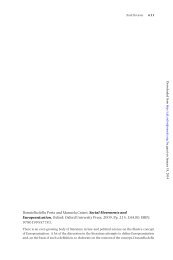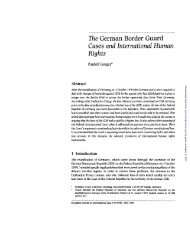Genocide and Restitution - European Journal of International Law
Genocide and Restitution - European Journal of International Law
Genocide and Restitution - European Journal of International Law
Create successful ePaper yourself
Turn your PDF publications into a flip-book with our unique Google optimized e-Paper software.
22 EJIL 22 (2011), 17–47<br />
None <strong>of</strong> the reported decisions <strong>of</strong> proceedings brought pursuant to this provision<br />
dealt specifically with cultural property. 21 Nor was a similar provision inserted in the<br />
subsequent Treaty <strong>of</strong> Lausanne. Nevertheless, the basic principles contained in the<br />
Treaty <strong>of</strong> Sèvres became an important precedent for Allied governments after World<br />
War II when they addressed the restitution <strong>of</strong> cultural property removed from groups<br />
persecuted by the Axis forces.<br />
B After World War II<br />
1 Crimes against Humanity <strong>and</strong> <strong>Genocide</strong>: The UNWCC <strong>and</strong> IMT<br />
During World War II, the Allied Powers warned that they would hold persons responsible<br />
for crimes perpetrated in territories controlled by Axis forces. 22 The UN War<br />
Crimes Commission (UNWCC), established to facilitate the investigation <strong>and</strong> prosecution<br />
<strong>of</strong> these crimes, was also m<strong>and</strong>ated to influence the development <strong>of</strong> ‘the protection<br />
<strong>of</strong> human rights <strong>of</strong> populations against violations <strong>of</strong> their own governments’. 23<br />
It did not confine itself to the violation <strong>of</strong> the laws <strong>and</strong> customs <strong>of</strong> war committed<br />
against Allied combatants or occupied civilians. Instead, it also investigated acts perpetrated<br />
against civilians who were stateless or Axis citizens on Axis territory <strong>and</strong>,<br />
over time, broadened its work to examine crimes committed against peoples because<br />
<strong>of</strong> their ‘race, nationality, religious or political belief . . . irrespective <strong>of</strong> where they<br />
were committed’. 24<br />
The UNWCC’s Committee III (Legal) maintained that it was not restricted to the<br />
1919 List in its endeavours to include persecution <strong>of</strong> minorities in the Commission’s<br />
brief. However, it did adopt it as a starting point. Committee III extrapolated the notion<br />
<strong>of</strong> ‘denationalization’, which it eventually renamed ‘genocide’. 25 Like the 1919 Commission,<br />
the UNWCC looked to international humanitarian law to defined denationalization<br />
<strong>and</strong> its criminalization in international law. 26 Unlike the 1919 Commission,<br />
it did not rely on the Martens clause in isolation, but as an aid in its purposive interpretation<br />
<strong>of</strong> the Hague Regulations. 27 It found that the acts <strong>of</strong> Axis forces fell under the<br />
21<br />
B. Holl<strong>and</strong>er, The <strong>International</strong> <strong>Law</strong> <strong>of</strong> Art for <strong>Law</strong>yers Collectors <strong>and</strong> Artists (1959), at 32–34.<br />
22<br />
Including the St James Declaration, 13 Jan. 1942, <strong>and</strong> Moscow Declaration, 30 Oct. 1943, in Punishment<br />
for War Crimes: The Inter-Allied Declaration Signed at St James Palace, London, on 13 Jan. 1942,<br />
<strong>and</strong> Related Documents (undated); <strong>and</strong> Declaration on Security, 9 Dep’t St. Bull. 308 (1943), <strong>and</strong> 38 AJIL<br />
(1944) 5.<br />
23<br />
UN Archives, Predecessor Archives Group, UN War Crimes Commission 1943–1949, New York, UN<br />
Doc.PAG-3/Rev.1 (1987), at para. ii.<br />
24<br />
Reports on Special Classes <strong>of</strong> Axis War Crimes, Note by the Secretary-General on the History <strong>of</strong> the Question,<br />
Origin <strong>of</strong> the Idea, C.72, 29 Jan. 1945, at 4–5, 6/34/PAG-3/1.1.0, UN War Crimes Commission,<br />
Predecessor Archives Group, UN Archives, New York (UNWCC).<br />
25<br />
See ‘Criminality <strong>of</strong> Attempts to Denationalise the Inhabitants <strong>of</strong> Occupied Territory’, Report presented by<br />
Committee III, C.149, 4 Oct. 1945, 6/34/PAG-3/1.1.0, at para. II, UNWCC.<br />
26<br />
Schwelb, ‘Crimes against Humanity’, 23 British Yrbk Int’l L (1946) 178, at 181.<br />
27<br />
Ećer, ‘Scope <strong>of</strong> the Retributive Action <strong>of</strong> the United Nations according to their Official Declarations (The<br />
Problem <strong>of</strong> “War Crimes” in connection with the Second World War)’, III/4, 27 Apr. 1944, 9/36/PAG-<br />
3/1.1.3, UNWCC, at 16.<br />
Downloaded from http://ejil.oxfordjournals.org/ by guest on January 18, 2014


